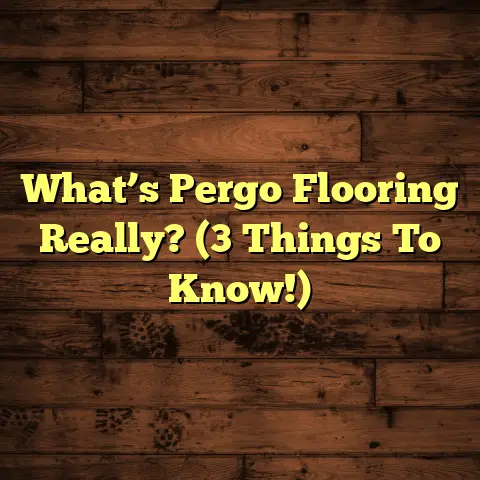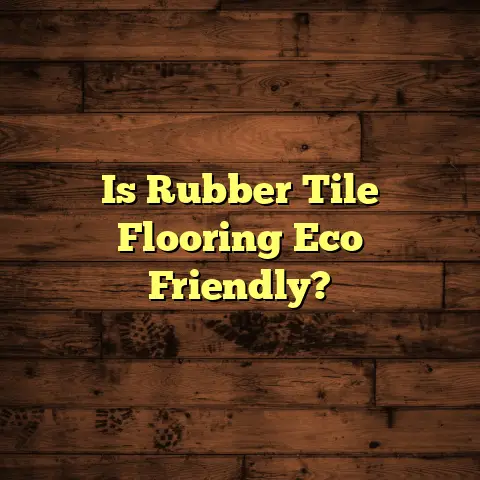Bubbling Laminate: Fix It NOW! (3 Causes!)
“I never thought my beautiful laminate floor would end up looking like this. The bubbles make it feel cheap and worn out. I need to fix it now!”
That’s a quote I hear all too often. As a flooring contractor with over 15 years of experience, I’ve seen the frustration bubbling laminate can cause firsthand.
It’s more than just an aesthetic issue; it’s a sign of underlying problems that can quickly escalate.
Let’s dive into what causes this annoying problem and how to tackle it.
Understanding Bubbling Laminate
So, what exactly is bubbling laminate?
Laminate flooring is basically a layered sandwich. You’ve got a core layer, often made of high-density fiberboard (HDF) or medium-density fiberboard (MDF), then a decorative photographic layer, and finally a clear, protective wear layer on top.
Bubbling happens when something gets between these layers, usually causing the core to swell and distort.
Why is it so important to address this quickly? Well, ignoring those bubbles isn’t going to make them go away.
In fact, they’ll likely get worse.
The swelling can spread, the wear layer can crack, and before you know it, you’re looking at replacing a whole floor instead of a few planks.
According to a 2022 report by the North American Laminate Flooring Association (NALFA), moisture-related issues account for over 60% of laminate flooring failures.
That’s a huge number! I’ve personally seen homes where a small spill that wasn’t cleaned up immediately turned into a bubbling disaster zone.
The Three Primary Causes of
Bubbling Laminate
Alright, let’s get to the nitty-gritty. In my experience, bubbling laminate usually boils down to these three culprits:
- Moisture Damage
- Poor Installation
- Low-Quality Materials
Let’s break them down one by one.
1. Moisture Damage
This is the BIG one. Moisture is enemy number one when it comes to laminate.
Think of that HDF or MDF core like a sponge. It loves to soak up water. When it does, it expands, causing the laminate to bubble and warp.
Where does this moisture come from? Here are a few common sources:
-
Spills: Obvious, right? But it’s not just big spills. Even small amounts of liquid left sitting on the floor can seep into the seams over time.
-
Humidity: High humidity levels, especially in bathrooms or basements, can cause moisture to condense on the floor and get absorbed.
-
Leaks: Leaky pipes, appliances, or even roof leaks can introduce significant amounts of water under your laminate.
-
Pet Accidents: I hate to say it, but pet urine is a major offender. It’s acidic and can quickly damage the laminate core.
I remember one customer, Sarah, who had beautiful laminate flooring installed throughout her kitchen and living room.
A small leak under her dishwasher went undetected for weeks. By the time she noticed the bubbling around the dishwasher, the damage was extensive.
She ended up having to replace a large section of her floor. The cost? Over $2,000. All because of a small, undetected leak.
2. Poor Installation
Even the best laminate flooring can fail if it’s not installed correctly.
I’ve seen some truly horrifying installations in my day. Here are a few common mistakes that can lead to bubbling:
-
No Acclimation: Laminate needs to acclimate to the room’s temperature and humidity before installation. If you skip this step, the planks can expand or contract after installation, leading to buckling and bubbling. I usually recommend at least 48-72 hours of acclimation.
-
Uneven Subfloor: Laminate needs a flat, level subfloor to sit on. If the subfloor is uneven, the laminate planks can flex and move, eventually causing the seams to separate and allow moisture in.
-
Insufficient Expansion Gaps: Laminate expands and contracts with temperature and humidity changes. You need to leave a small gap (usually around 1/4 inch) around the perimeter of the room to allow for this movement. If you don’t, the laminate can buckle and bubble as it expands.
-
Incorrect Locking Mechanism: Laminate planks lock together, creating a tight, water-resistant seal. If the planks aren’t properly locked, moisture can seep in between the seams.
I once had a client, Tom, who tried to install laminate flooring himself to save money. He didn’t acclimate the planks properly, and he didn’t leave enough expansion gap around the walls.
Within a few months, his floor started buckling and bubbling. He ended up calling me to rip it all out and reinstall it correctly.
His DIY project ended up costing him more than if he had hired a professional in the first place.
3. Low-Quality Materials
Not all laminate is created equal. Cheaper laminate flooring often uses lower-quality materials, which can make it more susceptible to bubbling.
Here’s what to look for:
-
Core Density: The density of the HDF or MDF core is crucial. A denser core is more resistant to moisture. Look for laminate with a core density of at least 700 kg/m3.
-
Wear Layer Thickness: The wear layer protects the decorative layer from scratches, dents, and moisture. A thicker wear layer is more durable. I recommend a wear layer of at least 12mm for residential use.
-
Water Resistance: Some laminate flooring is specifically designed to be water-resistant or even waterproof. These options are ideal for kitchens, bathrooms, and other areas prone to moisture.
-
Warranty: A good warranty is a sign that the manufacturer stands behind their product. Look for a warranty that covers moisture damage.
I had another customer, Maria, who chose the cheapest laminate she could find to save money on a rental property.
Within a year, the floor started bubbling in several areas, especially in the kitchen and bathrooms. The laminate had a very thin wear layer and a low-density core.
She ended up having to replace the entire floor much sooner than expected. In the long run, she would have been better off investing in a higher-quality product.
Diagnosing the Problem
Okay, so you’ve got bubbling laminate. How do you figure out what’s causing it? Here’s a simple guide:
-
Check for Moisture: This is the first step. Look for any signs of leaks, spills, or high humidity. Use a moisture meter to check the moisture content of the subfloor and the laminate itself. Normal moisture content for laminate is between 6% and 12%.
-
Inspect the Installation: Take a close look at the perimeter of the room. Is there an expansion gap? Are the planks properly locked together? Is the subfloor level? You can use a level to check for any unevenness.
-
Assess the Material Quality: If you have any leftover planks, take a look at the core. Is it dense and solid? Or does it seem flimsy and easily damaged? Check the wear layer. Is it thick and durable?
-
Consider the Location: Where is the bubbling occurring? Is it near a water source, like a sink or dishwasher? Is it in a high-traffic area? The location can provide clues about the cause.
I remember helping a client, David, diagnose a bubbling issue in his bathroom. He initially thought it was a plumbing leak, but after checking the moisture levels, I realized the problem was actually poor ventilation.
The bathroom was small and didn’t have a proper exhaust fan. The high humidity from showers was causing moisture to condense on the floor and get absorbed by the laminate.
We installed a new exhaust fan, and the bubbling issue resolved itself.
Immediate Solutions for
Bubbling Laminate
Alright, you’ve identified the cause. Now what? Here are some immediate solutions for each of the three causes of bubbling laminate:
Moisture-Related Bubbling:
-
Stop the Source: First and foremost, identify and fix the source of the moisture. Repair any leaks, improve ventilation, or address any other moisture issues.
-
Dry the Area: Use fans, dehumidifiers, or even a wet/dry vacuum to dry out the affected area as quickly as possible. The longer the laminate stays wet, the more damage it will sustain.
-
Replace Damaged Planks: If the bubbling is minor, you may be able to replace just the damaged planks. Carefully remove the damaged planks and replace them with new ones.
-
Consider a Moisture Barrier: If you’re replacing the floor, consider installing a moisture barrier underneath the laminate to prevent future moisture issues.
Poor Installation:
-
Correct Installation Flaws: If the bubbling is due to incorrect installation, you may be able to correct the flaws. For example, if there’s not enough expansion gap, you can carefully remove the baseboards and trim the laminate to create a gap.
-
Reinstall the Floor: In some cases, the only solution is to reinstall the entire floor. This is especially true if the subfloor is uneven or the planks weren’t properly locked together.
-
Hire a Professional: If you’re not comfortable correcting the installation flaws yourself, hire a professional flooring contractor to do the job.
Low-Quality Materials:
-
Repair or Replace: Depending on the extent of the damage, you may be able to repair the bubbling or you may need to replace the entire floor.
-
Invest in Quality: If you’re replacing the floor, invest in a higher-quality laminate product with a dense core, a thick wear layer, and a good warranty.
-
Consider Alternative Flooring: If you’re constantly battling moisture issues, you may want to consider alternative flooring options that are more resistant to water, such as tile or vinyl.
I had a client, Lisa, who had bubbling laminate in her kitchen due to a combination of poor installation and low-quality materials.
We ended up ripping out the entire floor and replacing it with a high-quality, water-resistant laminate product. We also made sure to install it correctly, leaving plenty of expansion gap.
Lisa hasn’t had any problems since.
Preventive Measures
The best way to deal with bubbling laminate is to prevent it from happening in the first place. Here are some preventive measures you can take:
-
Regular Cleaning: Clean your laminate floor regularly with a damp mop and a mild detergent. Avoid using excessive water, and always wipe up spills immediately.
-
Moisture Control: Control the humidity levels in your home, especially in bathrooms and basements. Use exhaust fans, dehumidifiers, or air conditioners to keep the humidity below 60%.
-
Proper Installation: If you’re installing laminate flooring yourself, make sure to follow the manufacturer’s instructions carefully. Acclimate the planks properly, ensure a level subfloor, and leave enough expansion gap.
-
Invest in Quality: Choose a high-quality laminate product with a dense core, a thick wear layer, and a good warranty.
-
Use Protective Mats: Place protective mats under furniture legs to prevent scratches and dents. Use area rugs in high-traffic areas to protect the wear layer.
-
Avoid Steam Mops: Steam mops can force moisture into the seams of the laminate, leading to bubbling. Avoid using them on laminate flooring.
I have a client, John, who has had laminate flooring in his home for over 10 years. He’s meticulous about maintaining it. He cleans it regularly, controls the humidity levels, and uses protective mats under his furniture.
His floor still looks as good as new.
Conclusion
Bubbling laminate is a common problem, but it’s not one you have to live with. By understanding the causes of bubbling, diagnosing the problem correctly, and taking appropriate action, you can fix your bubbling laminate and prevent it from happening again.
Don’t delay! Addressing bubbling issues promptly can save you time, money, and a whole lot of frustration in the long run.
Whether you’re fixing your current flooring, educating yourself on proper maintenance, or investing in higher-quality materials, take action today to protect your investment and keep your laminate flooring looking its best.
Good luck! And remember, I’m always here to help if you need me.





